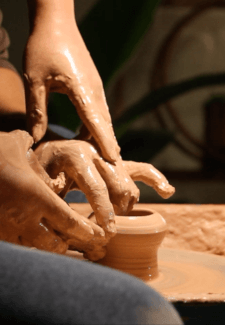In March 2020, when catch-ups were cancelled and toilet paper went missing from supermarket shelves, many of us turned to a particular kind of pastime to quell our anxieties. We looped, hooked, weaved and decorated, combatting the new and unknown with a simple age-old activity: craft.
And while restrictions have changed and strains have mutated, we continue to turn to the same creative activities for comfort amidst uncertainty. No matter how addictive Emily In Paris proves to be, for many of us, craft continues to take centre stage – our nightly streaming sessions replaced by coloured yarn, paint and pottery. But what is it about the “unprecedented events” of the past few years that spark in us a sudden desire to create? And why do we turn to craft in times of crisis?
Regardless of whether the pandemic pushed us to pick up our knitting needles or create our own candles, a quick flick through the events of the 20th and 21st centuries reveals that there’s more to craft than simply beating boredom…

“Sitting down and doing nothing can be really hard,” says 28-year-old crafter, Olivia Kilponen. “Weirdly, once you're up and running with crochet, it's easy to drop into that mindful state because of the repetitive movement in your hands.” Like so many others grappling with the uncertainty of the global pandemic, craft served as a unique kind of mindfulness activity for the Sydney-based lawyer, who found solace in the “little acts of creativity” she could fit into each day.
Inexpensive and easily accessible, tangible activities like crochet and knitting are an effective way to switch off from the demands of daily life. A large scale survey published in the British Journal of Occupational Therapy established a significant link between knitting frequency and stress relief, confirming what craft-lovers like Olivia know to be true. “The physical movement, combined with creative expression, makes crochet very mindful and highly restorative for our near-constantly stimulated brains.”

Over the past few years, other traditional crafts like weaving have also experienced a resurgence. Once considered daggy and outdated, they have been repurposed as mindfulness activities, providing the perfect antidote to the hustle and bustle of our modern lives. But, despite what the mesmerising videos on our social media feeds might suggest, craft as mindfulness is nothing new. Throughout history, arts and crafts have played an important role in the mental wellbeing of individuals and communities around the world, helping us cope with crises, deal with uncertainty and overcome adversity.
In both WWI and WWII, textiles arts like embroidery and stitching were used to help soldiers combat symptoms of PTSD and navigate through trauma. In 2011, after Christchurch’s 6.3 magnitude earthquake, craft served as a form of recovery for many of the locals impacted. Regardless of whether mosaic or jewellery-making was on the agenda, pop-up community craft groups helped to promote social connection, self-expression and self-led healing for hundreds of New Zealanders.

Looking back at the events of the past few years, the idea that “history repeats itself” really does ring true. Confined to a 5km radius for months on end, many of us turned to creative activities to regain some sense of control and take a much-needed break from doomsday scrolling. Some of us picked up sourdough bread-baking, others started growing vegetables on tiny terraced balconies and many more set to work sewing reusable masks for friends and family.
When the world around us seemed turbulent and chaotic, craft provided – and continues to provide – a sense of certainty, predictability and safety. For Olivia, crocheting throughout Sydney’s lockdown was just as much about “making something pretty” as it was about reclaiming her ability to enjoy herself when many of life’s pleasures were taken away. “When times are tough, it's those little sparks of comfort or beauty that we experience in creating something that really gets us through.”
.jpg)
While crafting our way through crisis provides undeniable wellbeing benefits, it brings with it a host of other life learnings. Engaging with creative activities as a form of therapy helps to free us from the pressures of modern-day life, be that the pursuit of perfectionism, the burden of hustle culture or the pervasive idea that we must “make something of ourselves”. In short, it reminds us that we have the permission to create simply for the sake of creating – because when you craft with the intention of calming your mind, it doesn’t matter if you drop a purl stitch or create a wonky clay cup.
While 2025 may not bring with it another government-enforced lockdown, there’s no denying that it has already delivered its own set of challenges. Regardless of whether you’re grappling with uncertainty or bearing the burden of self-isolation, immersing yourself in a creative activity is one of the most powerful weapons you can have in your wellbeing arsenal.
In fact, if the last few centuries are anything to go by, turning to craft in times of crisis might just provide us with the sense of comfort, control and connection we all need right now.




















